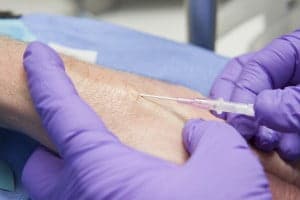
Editors’ note 11 August 2022: these two related blogs from 2015 have been kept as an example of how evidence can lead to changes in practice, but also that practice change and adherence to guidelines doesn’t happen seamlessly or all at once. The Cochrane ReviewCochrane Reviews are systematic reviews. In systematic reviews we search for and summarize studies that answer a specific research question (e.g. is paracetamol effective and safe for treating back pain?). The studies are identified, assessed, and summarized by using a systematic and predefined approach. They inform recommendations for healthcare and research. was updated again in January 2019 with the addition of two studies and no change to conclusions.
Last week, I wrote a blog Replacing peripheral venous catheters: have you ditched the routine? summarising reliable Cochrane evidence which supports replacing peripheral venous catheters (PVCs) only when clinically indicated. A previous version of the review informed The UK’s epic3 National Evidence Based Guidelines (2014) which recommend that short peripheral catheters should be replaced when clinically indicated, being both safe and cost-saving. In the UK, at least, I would expect this to be reflected in practice, but I already knew from Twitter conversations that routine replacement of PVCs is not uncommon. This week, I guest hosted a @WeNurses tweetchat to explore what’s happening now, what practitioners think about this evidence and whether it can support a change in practice where routine still rules.
Who joined the chat?
We had 63 contributers to the chat, sharing over 400 tweets, the majority nurses from different specialties and nursing students. It was great that we were also joined by a radiographer, giving us a view from another area of practice, and by Professors of Nursing Claire Rickard and Joan Webster, authors of the Cochrane review. Most were in the UK but we had contributions from Australia too, where Joan is Nursing Director for Research in at the Royal Brisbane and Women’s Hospital and Claire leads the AVATAR (Alliance for Vascular Access Teaching And Research) Group. The word cloud at the top was generated by the chat.
What determined routine PVC replacement policies?
Claire Rickard told us that routine re-siting of PVCs was changed from 24 to 48 hours in the 1980s, based on expert opinion only, and that the Centers for Disease Control changed its recommendation from 48 hourly to every 72-96 hours in the 1990s, based on cohort studies with 2500 people. There are dataData is the information collected through research. from many more patients in randomizedRandomization is the process of randomly dividing into groups the people taking part in a trial. One group (the intervention group) will be given the intervention being tested (for example a drug, surgery, or exercise) and compared with a group which does not receive the intervention (the control group). controlled trialsA trial in which a group (the ‘intervention group’) is given a intervention being tested (for example a drug, surgery, or exercise) is compared with a group which does not receive the intervention (the ‘control group’). of clinically indicated replacement. Epic3 guidelines are clear that clinically-indicated is the way to go but Claire said many guidelines have not been updated since new evidence came out.
Routine replacement still dominates
Many said that their local policy is to change them at 72 hours. There were some caveats. One said that it could be left longer if access is particularly difficult; another that replacement at 72 hours is usual and that although review to see if the PVC can remain in place is encouraged this doesn’t tend to happen. Adult nursing student Darren said “my placement area tend to change them after 4 days, regardless of need”. Another student, Lee, reported that changing at 72 hours was the norm in his placements, “unless difficult access, then monitor and record”. We were all horrified to hear that in one place the routine replacement policy has been retained ‘so junior doctors can get enough practice!’
But clinical indicators are the drivers for some
Micahel told us that “in the community a pragmatic approach is often adopted using VIP scale”. One contributor expressed concern about the accuracy of recording of VIP (Validated Infusion Phlebitis) scores and another cited this as one of the reasons for impending policy change, but this system was mentioned by several. “All care workers should know signs that should be reported”, commented Anne-Marie.

Radiographer Janice said she changes the PVC if she is unhappy with it, irrespective of time in situ, noting that some CT exams require high flow rates and that that they have to be mindful of IV contrast extravasation. Her practice is to flush with saline after the exam and check with the ward if the cannula can be left in. “As a cannulating radiographer it is a priority that I work with my nursing colleagues to ensure best practice”.
In paediatrics, re-siting when clinically indicated seems to be the norm and the idea of doing unnecessary procedures rightly regarded as unacceptable. As Claire asked, “why is that seen as safe but not in adults?”
Could it lead to complacency, one asked? Someone else thought it could, but this would be outweighed when balanced against the risks, and could be mitigated by training. The UK-based venepuncture and cannulation training folk, @vipvctraining, said their teaching is firmly based on the guidelines and they advocate replacing when clinically indicated.
According to Joan Webster, it’s “pretty simple really; if the site is red, swollen etc, take the device out. This may be after 10 hours or ten days …”
How long could a PVC remain in situ?
Claire says they are licensed by regulatory authorities for 30 days use and that she has used them for around 20 days. She also notes that most fail by 72 hours. “If they make it to 72 hours, let’s not ruin it!”
What about the patient?

Happily, there was plenty of discussion about consideration for the patient. Several pointed out that it’s important not to site, or re-site, PVCs unless there is a clinical need to do so, and to remove them as soon as no longer required. Comments included that they are painful, that anaesthetic creams can be ineffective and that cannulation skills are variableA factor that differs among and between groups of people. Examples include people’s age, sex, depression score or smoking habits. . Joan Webster said that returning patients who have taken part in their trialsClinical trials are research studies involving people who use healthcare services. They often compare a new or different treatment with the best treatment currently available. This is to test whether the new or different treatment is safe, effective and any better than what is currently used. No matter how promising a new treatment may appear during tests in a laboratory, it must go through clinical trials before its benefits and risks can really be known. now refuse to have their PVCs changed routinely! We liked this! “Patient power! No routine replacement thank you very much!” Patients and carers, it was noted, can be powerful advocates in achieving the implementation of evidence.
The argument should be over
We have good evidence that replacing PVCs when clinically-indicated does not put patients at increased riskA way of expressing the chance of an event taking place, expressed as the number of events divided by the total number of observations or people. It can be stated as ‘the chance of falling were one in four’ (1/4 = 25%). This measure is good no matter the incidence of events i.e. common or infrequent. of complications of IV therapy and and saves money. So are there any reasons NOT to do this? “Wouldn’t that be poor practice?” asked Charlotte. It seems that there are obstacles to change.
Sometimes tradition trumps evidence…
Kaye said that their policy (in New South Wales) is to replace routinely at 72 hours because blood stream infection (BSI) is a concern. Yet the evidence doesn’t support this. Cochrane authorSomebody responsible for preparing and, in the case of Cochrane Reviews, keeping up-to-date a systematic review. The term ‘reviewer’ is also sometimes used to refer to an external peer reviewer, or referee. Claire noted that there were half the BSIs in clinically indicated PVCs and that we don’t know whether making holes in skin 72 hourly causes BSI. Craig thinks that re-siting PVCs ‘just in case’ puts patients at risk.
It seems that culture is an obstacle to change here, with Kaye noting that “their argument is that translation into practice is difficult”. Depressingly, when asked if this is just a triumph of tradition/culture/habit over evidence, Kaye says “Absolutely! It has always won!” “The weight of tradition and experience of BSI outweighs the evidence for clinical replacement.”
Trusts not trusting?
While Trust policy should be evidence-based, it isn’t always. Several people thought Trusts would be reluctant to change their policies, despite the weight of evidence. Might there be concerns about accusations of neglect? Policies, it’s felt, are not easy to change and it was suggested that it would take a brave Trust to change their policy. Why should this be so, when all the evidence is in favour of clinically-indicated replacement? It was good to hear news of one Trust that has just done this, resulting in “30% less cannula insertions and no increase in VIP scores”.
Evidence into action: what will you do now?
There was a strong sense that the evidence necessitated action where practice isn’t following it, with talk of professional responsibility to raise concerns and to challenge current practice that has been shown not to be based on the best available evidence. It was agreed that staff are bound by policy but that policy should be challenged. Several people finished the chat determined to take action. Here are some of the intentions and suggestions:
- “Print off the epic3 Guidelines and take them to the Trust to help argue the case”
- “If you want to take something away, you have to give something in return. Implement a new PVC removal daily checklist”
- “If policy doesn’t follow best evidence then identify gatekeepers to change if unsure. Be the patients’ advocate always”
- “Evidence must be disseminated to IPC teams and policy revisited”
- “Key to PVC insertion and care is training, education and good audit cycle. So infection control and IVTeams can play a part”
- “Will share the chat summary with future radiographer @SCoRMembers cannulation course delegates”
- “I will be bringing this up with the ward sister in the morning!”
- “EBP must inform Trust policy – so time for a review of it, conversations start tomorrow!”
These last two came from nursing student Darren and from Craig, an Infection Prevention Nurse, and they were as good as their word. Darren was told by the ward sister that “she likes them out after three days” and when Darren told her about the evidence she said replacing after 72 hours is Trust policy. Other nurses there said this policy had been implemented as a knee-jerk reaction to an incident, instead of improving checking of PVCs. Darren is now going to contact infection control about this. Great news Darren and do go clutching epic3! Craig tweeted an update too: “we are on it and will be making change soon based on the latest evidence: tweetchat to action.” Fantastic!
Links:
Chapman S. “Replacing peripheral venous catheters: have you ditched the routine?”. Evidently Cochrane. 6 November 2015. Web. 21 November 2015. https://www.evidentlycochrane.net/replacing-peripheral-venous-catheters-have-you-ditched-the-routine/
You can see the details of the tweetchat here http://wecommunities.org/tweet-chats/chat-details/2581
Webster J, Osborne S, Rickard CM, Marsh N. Clinically‐indicated replacement versus routine replacement of peripheral venous catheters. Cochrane Database of Systematic ReviewsIn systematic reviews we search for and summarize studies that answer a specific research question (e.g. is paracetamol effective and safe for treating back pain?). The studies are identified, assessed, and summarized by using a systematic and predefined approach. They inform recommendations for healthcare and research. 2019, Issue 1. Art. No.: CD007798. DOI: 10.1002/14651858.CD007798.pub5.
Loveday HP, Wilson JA, Pratt RJ, Golsorkhi M, Tingle A, Browne J, Prieto J, Wilcox M. epic3: National Evidence-Based Guidelines for Preventing Healthcare-Associated Infections in NHS Hospitals in England. London: Richard Wells Research Centre, University of West London; 2013. Journal of Hospital Infection 2014; 86S1: S1-70. Available from: http://download.journals.elsevierhealth.com/pdfs/journals/0195-6701/PIIS0195670113600122.pdf
Tuffaha HW, Rickard CM, Inwood S, Gordon L, Scuffham P. The epic3 recommendation that clinically indicated replacement of peripheral venous catheters is safe and cost-saving: how much would the NHS save? J Hosp Infect 2014;87(3):183-4. doi: 10.1016/j.jhin.2014.04.004. Available from: http://www.journalofhospitalinfection.com/article/S0195-6701(14)00124-8/abstract
There is now an NIHR Signal available on this review:
NIHR Dissemination Centre, National Institute for Health Research. “NIHR Signal: Routine replacement of intravenous cannulae is unnecessary and costly”. NIHR Signal, 28 January 2016. Web. 4 February 2016.https://evidence.nihr.ac.uk/alert/routine-replacement-of-intravenous-cannulae-is-unnecessary-and-costly/
Page last updated 23 January 2019


